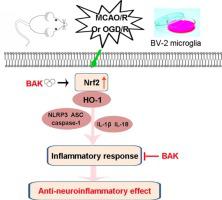Respiratory Physiology & Neurobiology ( IF 1.9 ) Pub Date : 2021-06-01 , DOI: 10.1016/j.resp.2021.103707 Yuewei Xu 1 , Xiaoming Gao 1 , Li Wang 1 , Manqin Yang 1 , Ruonan Xie 1

|
Cerebral ischemia/reperfusion (I/R) injury is a common cerebrovascular disease with high mortality. Bakuchiol (BAK), extracted from the seeds of psoralea corylifolia, exhibits anti-inflammatory effects on lung, kidney and heart injuries. However, the effect of BAK on brain I/R injury remains elusive. In our study, a cerebral I/R model in mice was established by 1-h middle cerebral artery occlusion and 24-h reperfusion (1-h MCAO/24-h R). Prior to it, mice were gavaged with BAK (2.5 or 5 mg/kg) per day for 5 days. BAK pre-treatment improved neurological deficit, and reduced infarct volume, cerebral edema and neuronal injury in MCAO/R-injured mice. BAK decreased the number of Iba1-immunoreactive cells in the brain, indicating a reduction of microglial activation. BAK also reduced the expressions of NLRP3, ASC, cleaved-caspase-1, IL-1β and IL-18. BAK triggered Nrf2 nuclear accumulation and elevated HO-1 level. Further, the role of BAK was explored in BV-2 microglia with 3-h oxygen-glucose deprivation/24-h reperfusion (3-h OGD/24-h R). It was found that the functions of BAK in vitro were consistent with those in vivo, as manifested by reduced NLRP3 inflammasome and activated Nrf2 signaling. In addition, BV-2 cells were treated with Brusatol, an Nrf2 inhibitor. Results showed that Brusatol partially reversed the protective effect of BAK on OGD/R-injured BV-2 cells, further confirming that BAK might exhibit its anti-inflammatory property via activating Nrf2 signaling. In short, BAK is more meaningful in improving cerebral ischemic injury through suppressing NLRP3-mediated inflammatory response and activating the Nrf2 signaling pathway.
中文翻译:

补骨脂酚通过调节 NLRP3 炎性体和 Nrf2 信号通路改善脑缺血再灌注损伤
脑缺血/再灌注(I/R)损伤是一种常见的脑血管疾病,死亡率很高。补骨脂酚 (BAK),从补骨脂的种子中提取,对肺、肾和心脏损伤具有抗炎作用。然而,BAK 对脑 I/R 损伤的影响仍然难以捉摸。在我们的研究中,通过 1 小时大脑中动脉闭塞和 24 小时再灌注(1 小时 MCAO/24 小时 R)建立了小鼠脑 I/R 模型。在此之前,每天给小鼠灌胃 BAK(2.5 或 5 mg/kg),持续 5 天。BAK 预处理改善了 MCAO/R 损伤小鼠的神经功能缺损,并减少了梗塞体积、脑水肿和神经元损伤。BAK 减少了大脑中 Iba1 免疫反应细胞的数量,表明小胶质细胞活化减少。BAK 还降低了 NLRP3、ASC、cleaved-caspase-1、IL-1β 和 IL-18 的表达。BAK 引发 Nrf2 核积累并升高 HO-1 水平。更远,BAK 在 BV-2 小胶质细胞中的作用与 3 小时氧葡萄糖剥夺/24 小时再灌注(3 小时 OGD/24 小时 R)进行了探讨。发现 BAK 的功能体外与体内一致,表现为NLRP3炎性体减少和Nrf2信号激活。此外,用 Nrf2 抑制剂 Brusatol 处理 BV-2 细胞。结果表明,Brusatol 部分逆转了 BAK 对 OGD/R 损伤的 BV-2 细胞的保护作用,进一步证实 BAK 可能通过激活 Nrf2 信号传导发挥其抗炎特性。总之,BAK通过抑制NLRP3介导的炎症反应,激活Nrf2信号通路,对改善脑缺血性损伤更有意义。











































 京公网安备 11010802027423号
京公网安备 11010802027423号